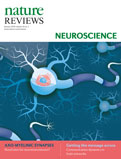|
| TABLE OF CONTENTS | |||||||||||||||||||||||||||||||||||||
| January 2018 Volume 19 Number 1 | |||||||||||||||||||||||||||||||||||||
| In this issue
| | |||||||||||||||||||||||||||||||||||
| |||||||||||||||||||||||||||||||||||||
 | |||||||||||||||||||||||||||||||||||||
| |||||||||||||||||||||||||||||||||||||
| PROGRESS | Top | ||||||||||||||||||||||||||||||||||||
| Lineage divergence of activity-driven transcription and evolution of cognitive ability Giles E. Hardingham, Priit Pruunsild, Michael E. Greenberg & Hilmar Bading p9 | doi:10.1038/nrn.2017.138 Activity-driven changes in gene transcription regulate synaptic development and function. Bading and colleagues describe recent evidence of lineage-specific changes in the gene regulatory regions that govern excitation-transcription coupling and consider how such changes may have contributed to the evolution of human cognitive abilities. Abstract | Full Text | PDF | |||||||||||||||||||||||||||||||||||||
| REVIEWS | Top | ||||||||||||||||||||||||||||||||||||
| Communication dynamics in complex brain networks Andrea Avena-Koenigsberger, Bratislav Misic & Olaf Sporns p17 | doi:10.1038/nrn.2017.149 The brain comprises complex structural and functional networks, but much remains to be determined regarding how these networks support the communication processes that underlie neuronal computation. In this Review, Avena-Koenigsberger, Misic and Sporns discuss the network basis of communication dynamics in the brain. Abstract | Full Text | PDF | |||||||||||||||||||||||||||||||||||||
| Anticipated moments: temporal structure in attention Anna C. Nobre & Freek van Ede p34 | doi:10.1038/nrn.2017.141 The brain uses predictable temporal structure to anticipate and select relevant events in time. Nobre and van Ede introduce different types of this 'temporal expectation' and its neural underpinnings, and describe how temporal expectation interacts with other forms of expectation in guiding adaptive behaviour. Abstract | Full Text | PDF | |||||||||||||||||||||||||||||||||||||
| Advertisement | |||||||||||||||||||||||||||||||||||||
| |||||||||||||||||||||||||||||||||||||
| PERSPECTIVES | Top | ||||||||||||||||||||||||||||||||||||
| OPINION Axo-myelinic neurotransmission: a novel mode of cell signalling in the central nervous system I. Micu et al. p49 | doi:10.1038/nrn.2017.128 Chemical communication between axons and their myelin sheath is an emerging concept in neurobiology. In this review, Stys and colleagues discuss how this 'axo-myelinic synapse' may play a role in metabolic control of the myelinating unit, modulate myelin dynamics and be a future therapeutic target. Abstract | Full Text | PDF | |||||||||||||||||||||||||||||||||||||
| Corrigendum: The nano-architecture of the axonal cytoskeleton Christophe Leterrier, Pankaj Dubey & Subhojit Roy p58 | doi:10.1038/nrn.2017.147 Full Text | PDF | |||||||||||||||||||||||||||||||||||||
| Erratum: Axo-myelinic neurotransmission: a novel mode of cell signalling in the central nervous system Ileana Micu et al. p58 | doi:10.1038/nrn.2017.166 Full Text | PDF | |||||||||||||||||||||||||||||||||||||
| Erratum: Synaptic transmission: Closer encounters Sian Lewis p58 | doi:10.1038/nrn.2017.167 Full Text | PDF | |||||||||||||||||||||||||||||||||||||
| |||||||||||||||||||||||||||||||||||||
| You have been sent this Table of Contents Alert because you have opted in to receive it. You can change or discontinue your e-mail alerts at any time, by modifying your preferences on your nature.com account at: www.nature.com/myaccount For further technical assistance, please contact our registration department For print subscription enquiries, please contact our subscription department For other enquiries, please contact our feedback department Springer Nature | One New York Plaza, Suite 4500 | New York | NY 10004-1562 | USA Springer Nature's worldwide offices: Macmillan Publishers Limited is a company incorporated in England and Wales under company number 785998 and whose registered office is located at The Campus, 4 Crinan Street, London, N1 9XW. © 2018 Macmillan Publishers Limited, part of Springer Nature. All Rights Reserved. |
 |









No comments:
Post a Comment